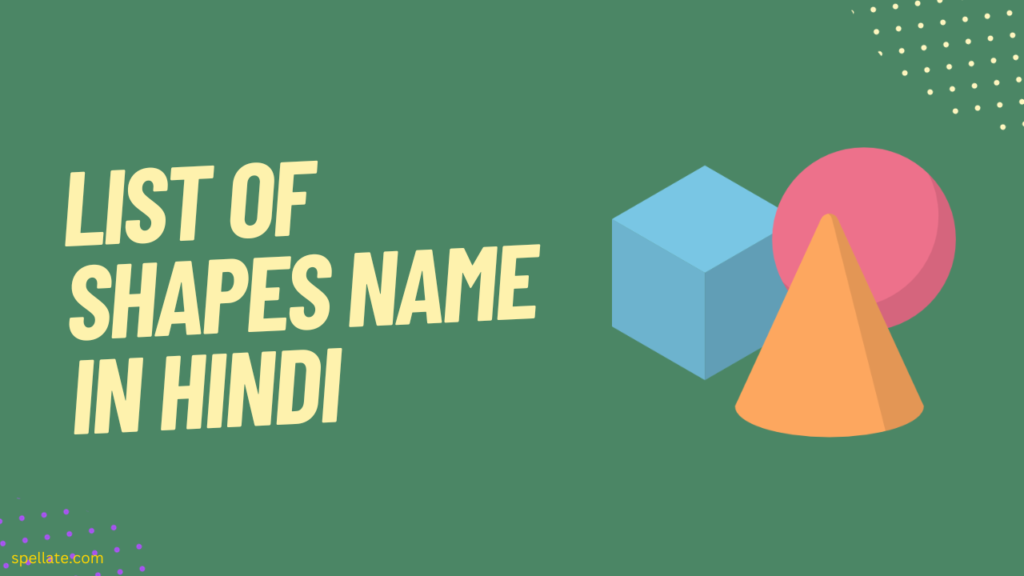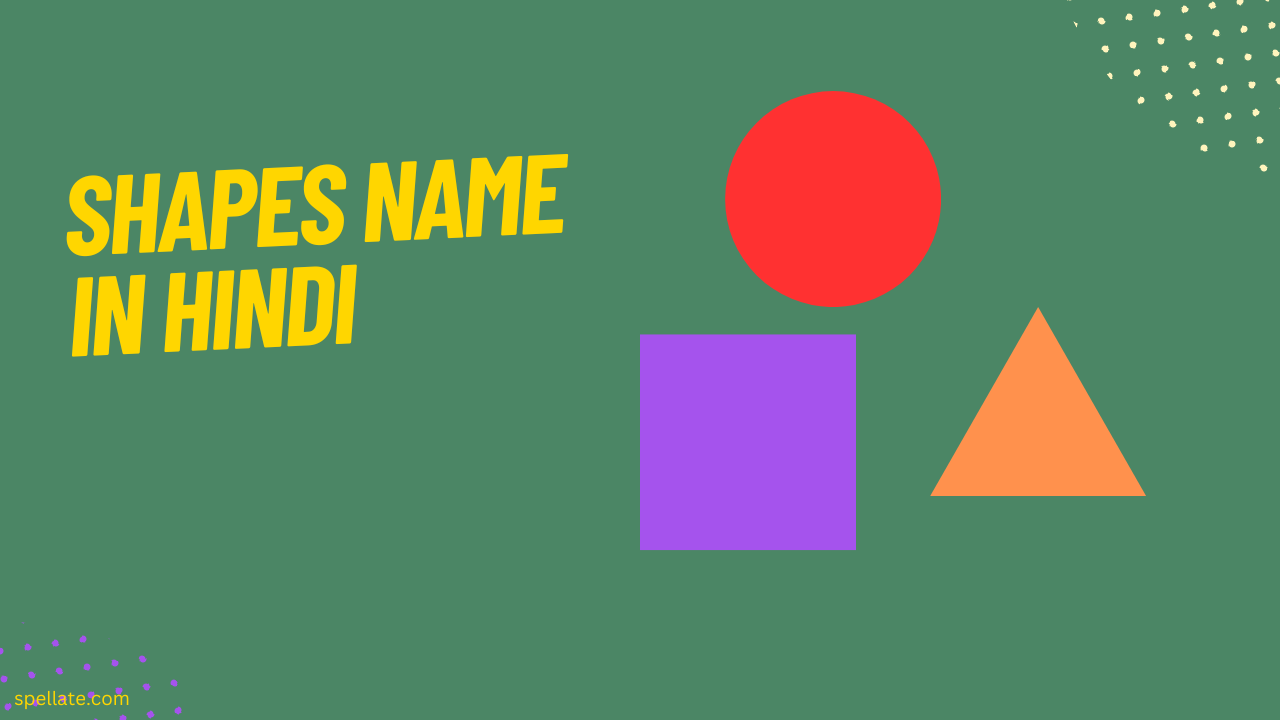“Shapes Name in Hindi” is a comprehensive guide to understanding and learning about various geometric forms in the Hindi language. In mathematics and everyday observations, shapes are fundamental in providing a visual language to describe the world around us. This guide aims to bridge the gap for Hindi-speaking individuals eager to explore the diverse world of shapes, from the basic building blocks to more complex geometric entities.
Delving into this resource, readers will discover a rich collection of shapes, each meticulously explained in Hindi. Whether you’re a student seeking to enhance your mathematical vocabulary or someone curious about the shapes that make up our surroundings, this guide is designed to be informative and accessible.
Join us on a journey where circles, squares, triangles, and polygons come to life with their Hindi names, enabling a deeper understanding of our daily geometric tapestry. Let “Shapes Name in Hindi” be your gateway to unlocking the language of forms and patterns, fostering a greater appreciation for the beauty and precision found in the world of geometry.
- List of Shapes Name in Hindi
- 1. Circle गोला (Cakra)
- 2. Point बिंदु (bindu aakaar)
- 3. Cube घन (Ghan)
- 4. Pyramid पिरामिड (piraamid aakaar)
- 5. Cylinder बेलन (Velanakaar)
- 6. Sphere गोला (Gola)
- 7. Cone शंकु (Sanku)
- 8. Hexagon षट्कोण (Satkon)
- 9. Octagon अष्टभुज (Ashtabhuj)
- 10. Triangle त्रिभुज (sambaahu tribhuj)
- 11. Star तारा (Tara)
- 12. Square वर्गाकार (Vargakaar)
- 13. Rectangle आयत (Aayat)
- 14. Quadrilateral चतुर्भुज (Chatarbhuj)
- 15. Trapezoid विषम चतुर्भुज (Visham Chaturbhuj)
- 16. Line रेखा (Rekha)
- 17. Cuboid घनाभ ( ghanaakaar aakaar)
- FAQ’S
- Conclusion
List of Shapes Name in Hindi

Here is the list of shapes name in Hindi and Shapes name in English.
1. Circle गोला (Cakra)
A circle, a two-dimensional geometric figure with a closed curve, has no edges or boundaries. Everyday items such as car tires, wall clocks that measure time, and lollipops exhibit this circular shape. Other common examples of circles in our surroundings include camera lenses, pizzas, Ferris wheels, rings, steering wheels, cakes, pies, and buttons. The characteristics of a circle, like its radius, diameter, circumference, and area, are not just theoretical concepts but have real-world uses.
2. Point बिंदु (bindu aakaar)
A point is a shape in coordinate space with a dimension of 0 and just one position. Point is the simplest shape in geometry. A point only has one x, y coordinate. Every point is straightforward. Oil wells, landmarks, and altitudes are features frequently defined using points with a NULL border. It is named with a capital letter and symbolized by a dot. A point has no size and solely represents the position (that is, zero length, zero width, and zero height).
3. Cube घन (Ghan)
A cube is a three-dimensional solid object in geometry surrounded by six square faces, facets, or sides, three of which meet at each vertex. When viewed from a corner, it looks like a hexagon, and its net is typically represented as a cross. One of the five Platonic solids, the cube is the only regular hexahedron. Cube has six equal faces, eight vertices, and twelve equal edges. Dice, ice cubes, and Rubik’s cubes are a few examples of objects we see daily with a cube shape.
4. Pyramid पिरामिड (piraamid aakaar)
A pyramid is a shape that exists in three dimensions. This structure features a polygon at the base, with flat triangular surfaces extending from each edge to converge at a single point, referred to as the apex. The formation of a pyramid occurs when these bases are linked to the top, and every edge of the base is connected to this apex, creating what’s known as the lateral face.
Interestingly, this pyramid structure is mirrored in something as commonplace as a tent. With its square bottom and sides forming triangles that connect at an upper point or apex, a tent can be seen as mirroring the structure of a pyramid when observed from certain angles.
5. Cylinder बेलन (Velanakaar)
A cylinder’s three-dimensional form is a curved surface joining two parallel circles. The formation of a right cylinder occurs when the centers of these circles intersect. The line segment linking these two centers, known as the axis, signifies the cylinder’s height. Everyday items such as pipes, water tanks, fire extinguishers, and soda cans often exhibit cylindrical shapes.
6. Sphere गोला (Gola)
A sphere is a three-dimensional geometric figure that mirrors the properties of a two-dimensional circle. It consists of points in three dimensions that maintain an equal distance from each other. The given point is identified as the sphere’s center, and ‘r’ signifies its radius. Spherical objects are prevalent in our surroundings and can range from celestial bodies like planets to everyday items like balls or globes.
7. Cone शंकु (Sanku)
A cone is a three-dimensional geometric form with a flat base and a smooth tapering apex or vertex. A cone comprises a collection of line segments, half-lines, or lines that connect the apex, the common point, to every point on a base in a plane other than the apex. Examples of cone shapes include ice cream cones, traffic cones, and party caps.
8. Hexagon षट्कोण (Satkon)
A hexagon is a closed, six-sided polygon in two dimensions according to geometry. A hexagon is made up of six angles and Six vertices. The words “hexa” and “gonio” both refer to six. Each internal angle in an irregular hexagon can be greater than or less than 120 degrees, and the sides are uneven in length. The most well-known examples of hexagonal structures in nature include honeycombs, snowflakes, the compound eyes of certain insects, benzene and other cyclic chemicals, and specific types of minerals.
9. Octagon अष्टभुज (Ashtabhuj)
An octagon is a closed two-dimensional figure with eight sides, eight vertices, and eight interior angles. An octagon is called a regular octagon if all of its sides and internal angles are of equal length; otherwise, it is called an irregular octagon. The fact that it has eight sides and eight angles distinguishes it from other geometrical shapes. Stop signs and other street signs are frequently shaped like an octagon.
You may also like
10. Triangle त्रिभुज (sambaahu tribhuj)
A triangle is a closed, two-dimensional object with three sides, angles, and vertices. A polygon also includes a triangle. Many commonplace items, including sandwiches, traffic signs, clothing hangers, and pool table racks, have a triangle shape. Triangles can be divided into three groups based on the lengths of their sides: scalene, isosceles, and equilateral. The length of the longest two sides of a triangle is larger than the length of the third side. Similarly, the third side of a triangle has a lesser length than the length difference between its two sides.
11. Star तारा (Tara)
A star shape, sometimes known as a star polygon, is a non-convex polygon and is most frequently a sort of decagon in geometry. A star shape is essentially a non-convex polygon that resembles a star. Since they weren’t researched all that much, star polygons don’t have a formal definition in geometry, although a regular star polygon has undergone much research. A self-intersecting equilateral and equiangular polygon is referred to as a regular star shape or regular star polygon.
12. Square वर्गाकार (Vargakaar)
A square is a shape that we frequently encounter in daily life. A square example is easy to locate, given some boxes’ edges and the throw cushions’ front shapes. Squares are also seen in city planning and architecture, where a city block is frequently square. A form with straight sides that starts and finishes at the same place is called a polygon. Any polygon with all sides being the same length and interior angles being the same size is considered regular. A quadrilateral is a polygon having four sides.
13. Rectangle आयत (Aayat)
The internal angles of a rectangle, which has four sides, are all exactly 90 degrees. The two sides come together at a straight angle at each corner or vertex. The rectangle differs from a square because its two opposing sides are of equal length. Rectangles can also be referred to as parallelograms because their opposite sides are equal and parallel. The most prevailing rectangular-shaped items we see daily include televisions, mobile phones, notice boards, walls, magazines, tennis courts, and TV screens.
14. Quadrilateral चतुर्भुज (Chatarbhuj)
A quadrilateral, a two-dimensional figure with four sides, is derived from the Latin words quadri and latus, meaning four and side, respectively. This polygon also has four angles and vertices. The image above illustrates an example of a quadrilateral. Various 2D shapes fall under quadrilaterals, including squares, rectangles, rhombuses, trapeziums, parallelograms, and kites.
15. Trapezoid विषम चतुर्भुज (Visham Chaturbhuj)
A trapezium, or trapezoid, is a four-sided flat figure with one set of parallel sides. The sides that aren’t parallel are known as the legs, and the parallel ones are called the bases. Interestingly, a trapezium can also have parallel legs. A practical, real-world example of a trapezoid-shaped object is the blade of a shovel, which forms a quadrilateral with two lines running in parallel and two not.
16. Line रेखा (Rekha)
A line represents a unique path created by a point moving through space. It is characterized by having just one dimension, which can alter its length, width, and trajectory. Often, the boundaries of shapes are determined by lines. Lines can take on various appearances – they may be wide or narrow, straight or curved, and aligned horizontally, vertically, or diagonally. Everyday items such as a pencil, a baseball bat, a phone charger’s cord, or a table edge provide practical examples of line segments.
17. Cuboid घनाभ ( ghanaakaar aakaar)
A cuboid is a six-sided solid known as a hexahedron in geometry. Quadrilaterals make up its faces. Cuboid is short for “like a cube.” A cuboid is similar to a cube in that a cuboid can become a cube by varying the lengths of the edges or the angles between the faces.
FAQ’S
How many shapes are there?
Basic shapes in geometry include the circle, square, rectangle, parallelogram, rhombus, kite, scalene triangle, isosceles triangle, equilateral triangle, acute triangle, obtuse triangle, right triangle, trapezoid, pentagon, and hexagon.
What characteristics do shapes share?
Answer: Right angles are found in every shape. One set of equal sides exists on every shape. Parallel sides can be found in all shapes.
Conclusion
Understanding the names of shapes is necessary for daily conversations, like when someone mentions the square plate. Here, you can expand your vocabulary and learn the names of shapes. This piece assists you in learning shape names in Hindi and English.
